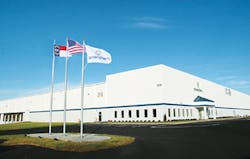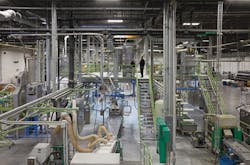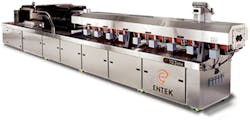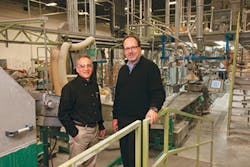State-of-the-art facility culmination of Americhem's plan to standardize
Americhem Inc., Cuyahoga Falls, Ohio, is a global producer of color masterbatches and additives with formulations that end up in a wide range of products. Its processing plant in Liberty, N.C., has been equipped with the most advanced technology.
Fillers and additives imbue resins with characteristics that are needed for the end products to perform in their respective environments, for example, improved weatherability in products used in building and construction or high heat tolerances for under-the-hood parts in automotive applications.
In Liberty, Americhem produces white dispersions, highly loaded carbon and nigrosine black dispersions and additive products in runs of 10,000 pounds or more. Fillers include talc, titanium dioxide and calcium carbonate. Larger runs of material are handled here, with lot sizes oaveraging 40,000 pounds. The plant also handles lots that are upwards of 300,000 pounds.
Activity in Liberty is based on a strategic plan to standardize equipment changeover times along with managing growth. In its operations, changeover times are critical. But the size of the equipment alone makes the process time-consuming. In this plant, the powder-handling receiver is large enough for a person to enter it. In order to change a filler many times, workers must brush down the powder-handling machine and pull out its filtration equipment.
Americhem is working to standardize the process.
"As we're seeing our product mix grow, we're having more and more demand for changeovers," said Liberty plant manager Scott Martin. "It's going to be a necessary part of our growth strategy."
Americhem's goal for Liberty is growth, and the plant and machinery choices reflect that.
"The vision was to develop a campus," said Doug Rich, director of global manufacturing for Americhem, in a recent interview at the plant in Liberty. "If you look at, out of all the Americhem sites, this one has the most ability to grow. We said, 'Let's take everything we know as we design a plant,' and we've done a very purposeful design for these blacks, whites, additives, high-volume products, and it is the most automated plant that we have. It was about putting in this technology that is going to deliver, putting in high-quality products very efficiently and effectively, and the vision is to grow it."
DESIGNING A PLANT
This location is a state-of-the-art Center of Excellence for Americhem. The 85,000-square-foot main facility has been purposefully designed with an open floor plan and linear flow, equipped with production lines that are flexible. The site has three full compounding extrusion lines and is capable of hosting eight. Current annual production capacity is 20 million pounds.
Low-touch, streamlined materials-handling practices are critical to the plant's design. For the most part, no operator touches the resins, Martin said.
Materials-handling pumps from Horizon Systems Inc. are located in a central location outside the building to keep noise down, he said. The bulk of the resins comes from silos and is delivered directly into the processing equipment. The campus has three silos, each with capacity of about 250,000 pounds. Three massive Novatec dryers perform the drying.
Entek, Lebanon, Ore., has supplied the plant's primary processing machines At its other plants, Americhem also has some KraussMaffei Berstorff and Coperion extruders.
"In recent years, I think Entek is the predominant equipment that we purchase," Martin said. The Liberty plant has two 103mm twin-screw extruders and one 53mm extruder.
Americhem used to manufacture its own extruders for the masterbatch business, Rich said, but made a strategic decision to move away from that. The first Entek line was commissioned in 2007.
"Around 2010, plans for this site were beginning to be put together," he said. "The concept was to take these differentiated blacks, whites and natural products out of the color plants, for a couple reasons. It added a lot of complexity to those plants with regard to cross contamination and run size. The thinking was that we will develop a plant that can run these differentiated products at high volume and low touch."
The Liberty plant has a 53mm Entek model for medium-lot compounding that can operate at 150 or 300 horsepower (hp) and 600 or 1,200 rpm. The machine has co-rotating screws and is controlled by an Ethernet-enabled PLC with a color interface.
Its 103mm extruders are for masterbatch compounding at 700 or 1,400 hp and 300 or 600 rpm, also with co-rotating screws. One 103mm machine is in a room specially designated for the production of the carbon black compounds. That space has its own air-handling systems.
"Historically, we've been in the commodity black business for many years specializing in smaller volumes from the other plants," Martin said. "The main objective for this facility was to have a separate area with ventilation where it was possible to keep the area clean and then have zero risk of cross contamination with our other white natural products."
Entek helped fully integrate the plant's three lines, from the feeders to the pelletizers. The lines have been set up so dosing can be done directly on the line rather than requiring pre-mixing; therefore, there is very minimal blending. The lines are equipped with Brabender side feeders. Pelletizers from Bay Plastics Machinery Co. are both strand and underwater types. The pelletizing method depends upon customer preference and the resin type.
Americhem developed a collaborative relationship with Entek.
"All this equipment, it was almost like we designed a lab machine but in production size," said Bill Petrozelli, regional sales manager, extruders, for Entek. "Almost all possibilities of options are on these machines. Their longest length-to-diameter [ratio], all kinds of options for side feed and liquid additives. If they get an inquiry about new products, they can make adjustments to that machine and they can run it."
The flexibility allows Americhem to handle products that require multiple feed streams, including liquid injection. For example, Americhem produces a highly complex compound that is used to manufacture a film packaging barrier. This compound requires a significant number of feed streams introduced at various points along the extruder as well as the use of a unique screw design. Without these capabilities, the ability to process products containing materials that are heat- and shear-sensitive would be impossible, according to Americhem. A number of very challenging products have found a home at Americhem because of the line capabilities.
"Americhem does a lot of customization to the equipment to fit our business," Martin said. "It is important that the vendor can work with us and we're not trying to go to a third party each time. They understand their machines and they understand what our goal is. They can provide the integration."
FLEXIBILITY IS KEY
In Liberty, the company takes on a lot of product trials as part of its growth strategy, said Martin. This is where the engineering of the equipment is key. Americhem grew up as a masterbatch and additives company, Rich said. The name of the game is the ability to get high levels of pigments into resins.
"You pretty much have purpose-built machines for that kind of work," he said. "This plant also can handle a wide variety of compounds. These kinds of capabilities that Bill is talking about would allow us to do some of the things like filled resin compounds, which you can't necessarily do in other plants."
"We don't have to say no to too many trials," Martin said. "It gives us a really strong background to take on new stuff."
The factory operates with three shifts, five days a week, with 27 employees. The biggest change over the years, according to officials, is the use of controls and automation. All the equipment is integrated and connected through an Ethernet network.
"There is a lot of controls work," Rich said. "The whole controls technology has really been a key growth area. You have to have that expertise or have a strong partnership with somebody [who has] that expertise because it controls your factory."
Americhem has its own central engineering group that has evolved from the days when the company made its own equipment. Americhem does a lot of its own design work for new equipment and new lines, and suppliers have to work in concert with that central engineering group.
The central engineering group also has benefitted, as has the company itself, from the use of technology. "Our central engineering guys, they're in Cuyahoga Falls," Rich said. "They are supporting our plants all around the world. If there are any issues, they can get online, they see what's happening, they figure it out. They don't have to physically travel to the site."
Angie DeRosa, managing editor
Contact:
Americhem Inc., 330-929-3125, www.americhem.com




